Embeddable RFID Tags - What do I Need to Know?
What Are Embeddable RFID Tags?
Embeddable RFID tags are a type of tag specifically made to be embedded into an object and not simply attached to the surface.
Are There Different Types of Embeddable RFID Tags?
Embeddable RFID tags are available in different form factors for use on a variety of assets.
- Metal Mount Hard Tags– Specialized for embedding into a metal asset or tool. Tags embedded in metal cannot be completely covered by metal or they will not work.
- Non-Metal Mount Hard Tags – Specialized for embedding into a plastic, wood, glass, or other non-metallic item.
- Laundry Tags – Specialized for embedding into fabric by creating a pocket in the fabric and sewing it together on all four sides.
- Dry Inlays – Dry inlays can be embedded into paper, cardboard, wristbands, or cards and badges.
- Animal Tags – Animal tags can be embedded into animals for livestock or animal identification.
Why Embed RFID Tags?
The tagging scenarios below are typically red flags for when embedding an RFID tag should be considered over another attachment method.
Compromised Functionality
If placing a tag on the surface of an item would interfere with the use or functionality of that item, embedding the tag is most likely the best option. One of the best examples of this is tagging tools. Most hand tools, regardless of the industry they are used in, will need to be used frequently and an RFID tag mounted on the surface would compromise the usage. Embeddable tags are commonly used to track tools such as scalpels, wrenches, hammers, or even landscaping equipment.
Protection
Embeddable tags are also often used in applications with harsh environments where the tag could be knocked off the surface of the asset and lost. This could be caused by machinery, close proximity to other assets, or even extreme weather conditions. In these cases, the RFID tag must be protected, and one of the best ways to do this is embedding.
Concealment
Another situation that would benefit from embeddable tags is if the application was customer facing and the tag could be damaged or removed by individuals. One example of this is inventory tracking in retail stores. Manufacturers that tag clothing for quicker and more accurate inventory management usually choose to embed the RFID tag inside the sales/price tag. Because the tag is not easily seen or recognized, most customers do not disturb these tags and they can be easily removed after purchase.
What Are Some Examples of Embeddable Tags?
Embeddable Wire Tag – The Embeddable Wire Tag has a unique shape and is created from incredibly durable vulcanized rubber. Ideal for Laundry Tracking and Non-Metal Asset Tracking.

Omni-ID Fit 400P – The Omni-ID Fit 400P is specially made to be embedded into plastic assets and has a high sensitivity design all in a small form factor. Ideal for Non-Metal Asset Tracking and Tool Tracking.

Xerafy Dot Wedge XS – The Xerafy Dot Wedge XS is made from a high-performance polymer, allowing it to withstand harsh environments and applications, like tracking pipes in laydown yards. This unique design allows the tag to fit into a created hole in metal assets without requiring any epoxy. Ideal for Metal Asset Tracking and Tool Tracking.
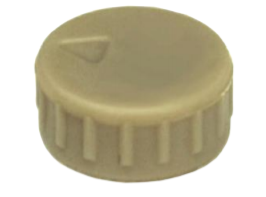
SMARTRAC Web RFID Dry Inlay – The SMARTRAC Web Dry Inlay is a flexible dry inlay that can be used on plastic, cardboard, or glass items. Dry inlays, like the SMARTRAC Web, can be embedded in paper to create a tag like the Tageos EOS-410 RFID Hang Tag, which is perfect for tagging apparel in retail applications. HF Dry Inlays, similar to the SMARTRAC H145 TIPLS, are also embedded into paper for Passport Identification. Ideal for Inventory Management or Item Identification.
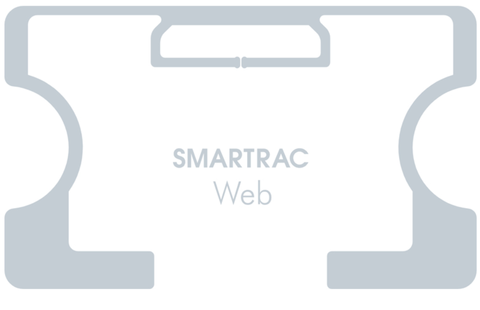
Fujitsu WT-A533 Laundry Tag – The Fujitsu WT-A533 Laundry Tag has a small, flexible form factor allowing it to be discreet in customer-facing applications. This tag can survive the laundering process and can be embedded into a created pocket in a garment or textile. Ideal for Laundry Tracking.
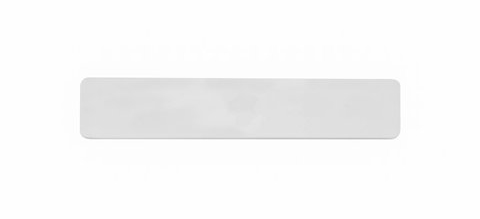
Click here to see more Embeddable RFID Tags
What Applications use Embeddable Tags?
Applications that commonly used embeddable tags are:
- Small Asset Tracking/Management/Identification – electronics, radios, machinery
- Tool Tracking – medical tools, construction tools, landscaping tools, etc.
- Large Asset Management/Identification/Preventative Maintenance – large machinery, office equipment, pipes, construction assets
- Returnable Asset Tracking/Identification – plastic pallets, crates, shipping containers
- Laundry Tracking – textiles, garments, linens
- Animal Management/Identification – livestock, domestic animals
When Should I Not Embed RFID Tags?
Unless the item has a small pocket or cavity that will fit the RFID tag’s form factor, a hole or pocket will typically have to be created in the item.
If creating a hole or pocket in the asset would somehow compromise or damage the asset, do not choose embedding as the attachment method. For example, if the asset is a thin steel bar and drilling a hole in the bar would compromise the bar’s integrity or usage, then embedding an RFID tag should not be done.
The rest of the post will focus mostly on Metal & Non-Metal Mount Hard Tags being the largest subset of Embeddable RFID Tags.

What Kind of Read Range do Embeddable Tags Have?
The amount of read range, like most RFID tags, depends on a few factors, especially the size of the tag. In most RFID applications, the size of the tag directly corresponds with the achievable read range: the larger the tag, the longer the read range. Smaller embeddable tags usually have a read distance of up to 1 meter or 3 feet, while some of the larger tags, like the Xerafy Micro-iN, can be read up to 6 meters or 20 feet. All embeddable tags specify what material they should be mounted on, whether that is metal or non-metal. If the tag specifies that it should be embedded in a metal object and is not, the read range will be greatly reduced, nonexistent.
What Advice do you Have on Embedding RFID Tags?
Tag Depth is Important.
When drilling or creating a hole for the RFID tag to reside in, it is important to only make the hole as deep as the tag’s height. The RFID tag should always be flush mounted on the asset so that the Face is level with the asset’s surface. If the RFID tag is below the asset’s surface, the read range of the tag could suffer due to increased multipath effects.
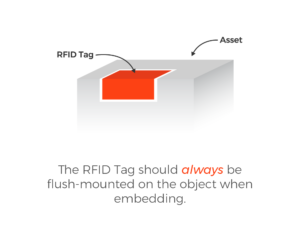
If Unsure, use Tag Placement Guides.
If you are unsure about how to place the tag inside the drilled hole, some embeddable tags have the option of purchasing with an additional carrier that helps to mount the tag. An example of a tag that has an optional carrier is the Omni-ID Fit 400 Embeddable Tag.
Do Not Over or Under Cover Embedded Tags.
The RFID tag should be covered on all sides and the bottom face, exposing the top face for reading. RFID tags should be covered by the asset’s material on all sides except one face. When embedding RFID tags, all sides and the bottom face (Face Y) would be covered. Face X would then be covered in epoxy. These tags are designed to perform specifically when one Face and all sides are covered by the asset’s material – either metal or plastic dependent on what material the RFID tag is designed for. Do not cover too much or too little of the tag during placement.
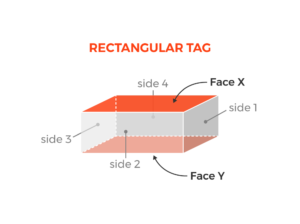
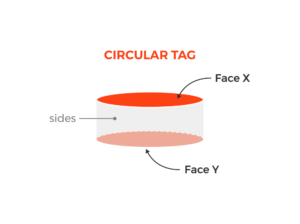
On a Metal Asset, Typically try to Embed the Tag on the Longer Side of the Asset.
Most manufacturers suggest the RFID tag should be mounted on the longer side of the asset as opposed to the shorter side. This is because metal-mount RFID tags are designed to use their immediate surface as an extension of their antenna. The longer their immediate surface, the longer their antenna and the longer the tag’s potential read range.
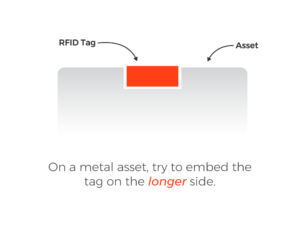
Do not use a Metal-Mount Tag on a Plastic Asset, and Vice Versa.
During the manufacturing process, an RFID tag’s antenna is tuned and designed to work on specific material in order to maximize its read range. When the tag is not mounted on the type of material suggested, the tag’s antenna does not function as well, and the read range is greatly diminished. In some cases, the tag will not work at all.
This is important to understand because a large percent of embeddable hard tags are designed for metal-mount assets and will not work on plastic, glass, or other surface materials.
Be Cognizant of Temperatures.
The embedded RFID tag and epoxy will have to undergo any processes that the asset undergoes, which could mean high temperatures or rugged environments. Ensure that the tag can withstand these processes as well as the chosen epoxy. If the tag can withstand the high temperatures, but the epoxy cannot, the epoxy could melt, and the tag could fall off at any point. If the asset’s material swells in humidity or constricts in cold weather, make sure your tag and attachment method allow for these changes.
Testing is Crucial.
Similar to all RFID applications, testing is crucial. All environments are unique, and each tag and system should be tested in the application environment before deploying or expanding. It’s recommended to embed a test tag or several of test tags on each asset to get a proper estimate of read range on the given material in the application environment.
Conclusion
If you would like to learn more about all things RFID, check out our website, our YouTube channel, comment below, or contact us. Special thanks to Matt Hardy from Xerafy for his help on this article!
To read more about RFID tags, check out the links below!
